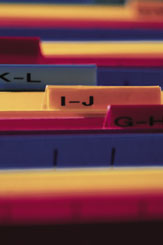 ORGANIZING YOUR KITCHEN
ORGANIZING YOUR KITCHEN THE FIVE CENTERS
Set up a "station" for each of the five basic kitchen activities. Keep your equipment nearest the appropriate center, making it easier for you to perform kitchen duties:
1. Cleaning (sink, dishwasher, trashcan, soap, rags, sponges, etc.)
2. Cooking (stove, pots, pans, microwave, toaster, etc.)
3. Food prep (countertop, mixing bowls, blender, measuring cups, etc.)
4. Food storage (refrigerator, Tupperware, canned foods, etc.)
5. Serving (dishes, linens, candles, flatware, glasses, etc.)
THE TRIANGLE THEORY
Pay attention to your movement from one center to the next. You should be able to reach major appliances in only a few steps. Set up your kitchen as a triangle, moving from stove to sink to refrigerator and keep these paths clear of obstacles. (Trash cans, dog dish, etc.)
TRANSFORM YOUR EXISTING STORAGE SPACE
Storage tools can do wonders with your current spaces
Stepped shelving makes use of the back space in a deep cabinet
Drawer dividers keep utensils under control
Rectangular storage containers take up less space than round ones
Choose containers that stack
Line up pot lids and flat cookware in a vertical rack
Use overhead bins, cup hooks, and racks for hanging storage
Use pullout racks and stacking bins to make use of dead space
Save your counters for items you use daily
ORGANIZING YOUR CABINETS
Limit yourself to one category of paraphernalia per area (ex: glasses on one shelf, dishes on another)
Avoid storing food and cookware together in the same cabinet
Group your foods together in categories for easy access (ex: canned vegetables, baking goods, breakfast foods)
Alphabetize spices in a rack to make them easier to locate
Keep small packets (gravy, Jell-O, sauces) together in a basket
HONEY, IS THIS GOOD?
Remember that even non-perishable foods go bad
Go through your cabinets and clean them out periodically
Follow some basic guidelines about the shelf life of food
KITCHEN DESIGN
Ask some questions that influence the design of your kitchen:
How often do you shop for groceries?
Do you buy in bulk?
What do you normally buy (more boxed, frozen, fresh, etc.)?
Do you eat in the kitchen or in the dining room?
Is the kitchen a social and family center?
Do you have need of a computer in the kitchen?
Do you want a TV or CD player in the kitchen?
How many meals a day do you cook?
How many people do you cook for?
Do you do much large-scale entertaining?
Do you prepare many elaborate or complicated meals?
Do you bake often?
Do you want a "pass-through" to the dining room?
What items do you use most frequently in your kitchen?
How many recipe books do you have?
How often do you use your recipe books?
Do you have any physical limitations?
Are you tall or short (determines high and low storage)?
Wesley Brown is the founder of Simplified Solutions Professional Organizers. Wesley is an organizing consultant, trainer, and speaker.
Contact us: www.simplifiedsolutions.ca
Copyright © 2013 Simplified Solutions all rights reserved



